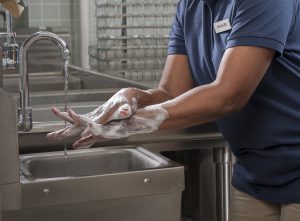Unit 1 – Food Safety
1.4 Promoting Food Safety
The Food Safety and Inspection Service (FSIS) of USDA, work with FDA and CDC to ensure our we have a safe and healthy food supply. The FoodSafety.gov website serves an important role in ensuring food safety in the United States. Although you can often detect when mold is present, you can’t see, smell, or taste bacteria or other substances in food that can cause food poisoning. Therefore, it is crucial to take measures to protect yourself from disease.
Four Steps For Food Safety
The four most important steps for handling, preparing, and serving food are[1]:
- Clean. Wash hands thoroughly. Clean surfaces often and wash utensils after each use. Wash fruits and vegetables (even if you plan to peel them). See FDA’s Clean Infographic
- Separate. Don’t cross-contaminate food during preparation and storage. Use separate cutting boards for produce and meat, poultry, seafood, and eggs. Store food products separately in the refrigerator. See FDA’s Separate Infographic
- Cook. Heat food to proper temperatures. Use a food thermometer to check the temperature of food while cooking. Keep cooked foods hot until served. See FDA’s Cook Infographic
- Chill. Refrigerate any leftovers within two hours. Never thaw or marinate food on the counter. See FDA’s Chill Infographic
For more information on these four-step, visit the FoodSafety.gov website.
The World Health Organization (WHO) has similar guidelines known as the Five Keys to Food Safety. Their first four keys are the same as the steps described above. Their fifth key deals with using safe water. Globally, many countries have contaminated water and use it for drinking and washing foods—unsafe water results in many illnesses and deaths, especially among infants and children.
VIDEO: WHO: Five Keys to Food Safety. March 15, 2015. (4:05 minutes)
The video begins with the three types of microbes. The “good” are used in making yogurt, cheese, and fermented meats like pepperoni. The “bad” ones make foods smell, taste, and look bad. The third type are the “dangerous ones” that are pathogenic and make you sick. They can’t be seen but hide inside foods and are very prolific. The video ends by introducing the Five Keys to Food Safety.
Handwashing
The COVID-19 pandemic educated us on the importance of handwashing, and it is the first line of defense in protecting yourself from foodborne illnesses. Proper handwashing reduces the spread of many respiratory and diarrheal infections spread from one person to the next.

The CDC, FDA, USDA recommend washing hands frequently, including:
- Before, during, and after preparing food.
- Before and after eating food, caring for someone at home who is sick with vomiting or diarrhea, and treating a cut or wound
- After using the toilet, changing diapers or cleaning up a child who has used the toilet, blowing your nose, coughing, or sneezing, touching an animal or garbage
Five Steps to Proper Handwashing
There’s a right and a wrong way to wash your hands. The wrong way is turning the tap on with your dirty hands, sticking your hands under the water for a second, turning off the tap, and drying your hands on your shirt. That may be a speedy way, but it does nothing to destroy the microbes on your hands, and you are recontaminating them by using your shirt as a drying cloth.
The appropriate method requires soap and takes about one minute to complete. The CDC recommends the following five steps:
- Wet your hands with clean, running water (warm or cold), turn off the tap and apply soap.
- Lather your hands by rubbing them together with the soap. Lather the backs of your hands, between your fingers, and under your nails.
- Scrub your hands for at least 20 seconds. Need a timer? Hum the “Happy Birthday” song from beginning to end twice.
- Rinse your hands well under clean, running water.
- Dry your hands using a clean towel or air dry them.
The CDC, FDA, USDA recommend washing hands frequently, including:
- Before, during, and after preparing food
- Before and after eating food, caring for someone at home who is sick with vomiting or diarrhea, and treating a cut or wound
- After using the toilet, changing diapers or cleaning up a child who has used the toilet, blowing your nose, coughing, or sneezing, touching an animal or garbage [2]
The Pros and Cons of Hand Sanitizers
If soap and water are not available, alcohol-based hand sanitizers help reduce microbes. The sanitizer should contain at least 60% alcohol. Look at the product label to ensure it has at least 60% alcohol.
The benefit of hand sanitizers is that it’s easy to carry a bottle of it in your purse or keep it on your desk. And it does quickly reduce the number of microbes on hands in many situations. However, the negative aspects are listed below.
- Sanitizers do not get rid of all types of germs.
- Hand sanitizers may not be as effective when hands are visibly dirty or greasy.
- Hand sanitizers might not remove harmful chemicals from hands like pesticides and heavy metals.
How to Use Hand Sanitizer
- Apply the gel to the palm of one hand (read the label to learn the correct amount).
- Rub your hands together.
- Rub the gel over your hands and fingers (and under your fingernails) until your hands are dry. The process takes around 20 seconds.
Food Safety When Buying Food
Buy food from reputable grocers with clean, sanitary facilities. Before buying food, scrutinize it and consider the following;
- Do not buy canned goods with dents or bulges; bulging is a sign of Clostridium botulinum contamination.
- Examine cured and cooked meats for mold.
- Avoid torn, crushed, or open food packages.
- Do not buy food with frost or ice crystals, which indicates that the product is old or has been thawed and refrozen.
- Put fresh meat, poultry, and seafood separate from other items in your shopping cart to avoid c
Storing Food to Keep It Safe
Refrigerate perishable foods quickly, within two hours. Keep the refrigerator temperature at 40°F (or 4°C) or colder. Other storage recommendations are:
- Store eggs in a carton on a shelf in the refrigerator and not on the refrigerator door where the temperature is warmest.
- Wrap meat packages tightly and store them at the bottom of the refrigerator so that juices won’t leak out onto other foods.
- Keep raw meat, poultry, and seafood in a refrigerator no longer than two days. Otherwise, store the items in the freezer at 0°F (or −18°C).
- Store potatoes and onions in a cool, dark place, but not under a sink because leakage from pipes could contaminate them.
- After opening cans of foods, place them into storage containers and promptly put them in the refrigerator.
- Eat leftovers within three to five days, so mold does not have a chance to grow.
Another important aspect is knowing when to keep food and when to throw it out. The Still Tasty website explains how long refrigerated food remains fresh.
Preparing Raw Foods Safely
To help prevent cross-contamination, wash hands thoroughly before preparing food and every time after handling raw foods. Other food prep recommendations include:
- Rinse fresh fruits and vegetables thoroughly under running water to clean off dirt and pesticide residue[3].
- Defrost meat, poultry, and seafood in the refrigerator, microwave, or in a water-tight plastic bag submerged in cold water.
- Never defrost at room temperature because that is an ideal temperature for bacteria to grow.
- Marinate foods in the refrigerator and discard leftover marinade after use because it contains raw juices.
- Always use clean cutting boards, which should be washed with soap and warm water by hand in a dishwasher after each use, or sanitize with a solution of 5 milliliters (1 teaspoon) chlorine bleach to about 1 liter (1 quart) of water.
- Use separate cutting boards for fresh produce and raw meat.
- Wash the top before opening canned foods to prevent dirt from coming into contact with food.
Preventing Contamination in Cooked Foods
Cooked food is safe to eat only after it has been heated to an internal temperature that is high enough to kill bacteria. You cannot judge the state of “cooked” by color and texture alone. Instead, use a food thermometer to be sure.

The appropriate minimum cooking temperature varies depending on the type of food:
- Seafood to 145°F
- Beef, lamb, and pork to 160°F
- Ground chicken and turkey to 165°F
- Poultry breasts to 165°F
- Whole poultry and thighs to 180°F.
When microwaving, rotate the dish and stir contents several times to ensure even cooking.
Serving and Storing Food Safely
The possibility of bacterial growth increases as the temperature drops in cooked foods. So, hot foods should be kept above the safe temperature of 140°F, using a heat source such as a chafing dish, warming tray, or slow cooker. Kee cold foods at 40°F or lower.
Keep all foods covered to block exposure to any mold spores hanging in the air when serving food. Use plastic wrap to cover foods you want to remain moist, such as fresh fruits, vegetables, and salads. After a meal, do not keep leftovers at room temperature for more than two hours. Left-overs should be refrigerated as promptly as possible. It is also helpful to date leftovers, so they can be used safely, generally three to five days, when stored in a refrigerator.
Review Questions
Attributions:
- The University of Hawai‘i at Mānoa Food Science and Human Nutrition Program, “ Food Safety” CC BY-NC 4.0
- US Department of Health and Human Services. "Keep Food Safe." Food Safety.gov. Accessed December 21, 2011. http://www.foodsafety.gov/keep/index.html. ↵
- CDC, Clean Hands. Accessed from https://www.cdc.gov/clean-hands/about/index.html. January 28, 2025 ↵
- California Department of Pesticide Regulation. “Pesticides and Food: How We Test for Safety.” Pesticide Info: What You Should Know about Pesticides, no. #E09/REV. Accessed December 21, 2011. http://www.cdpr.ca.gov/docs/dept/factshts/residu2. ↵
United States Department of Agriculture
Food and Drug Administration
Centers for Disease Control and Prevention
The process by which bacteria or other microorganisms are unintentionally transferred from one substance or object to another, often resulting in a foodborne illness.
The process by which bacteria or other microorganisms are unintentionally transferred from one substance or object to another, with harmful effect.

